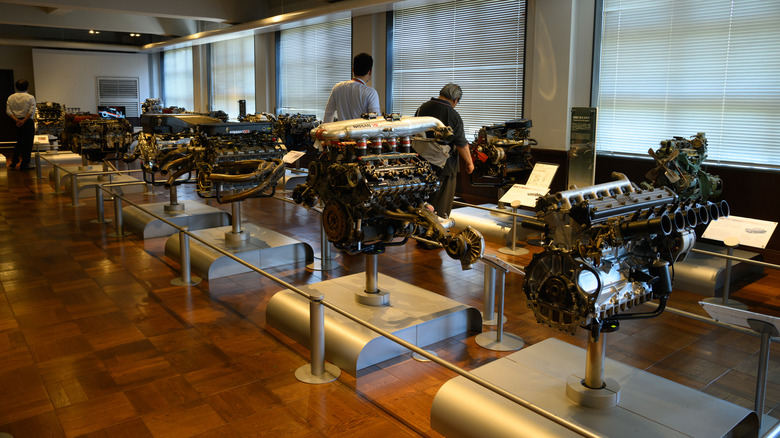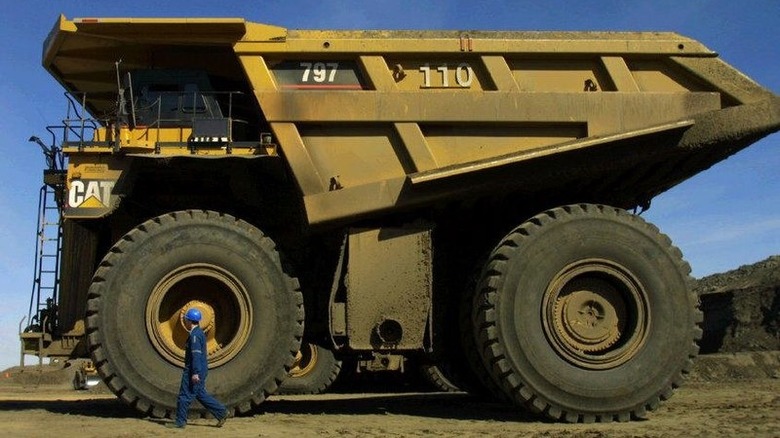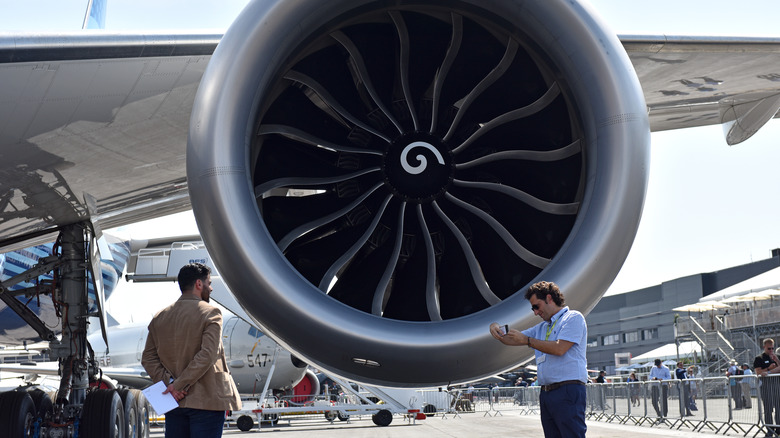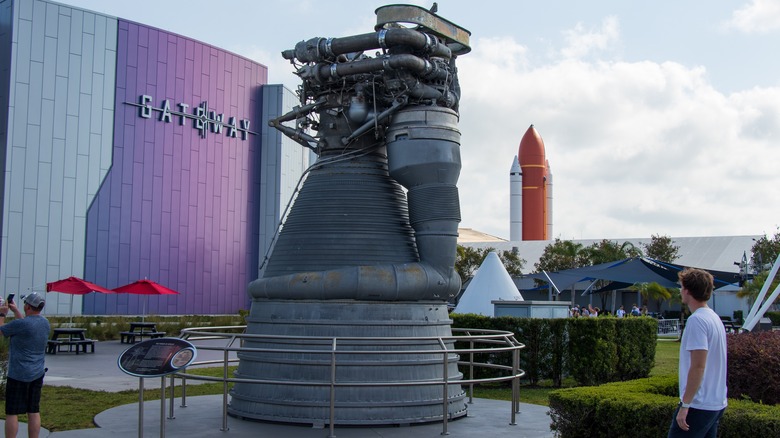5 Of The World's Biggest Engines That Are Truly Massive
Since the dawn of time, man has seemingly been tinkering with engines. Heron of Alexandria, who lived from 10–85 CE in Alexandria, Egypt, is credited with creating the first steam-powered engine, and the three main parts that make up a modern internal combustion engine — the crank, camshaft, and flywheel — originated even further back in history.
Take the humble flywheel, created by some industrious craftsman in ancient Sumer back around 3,250 BCE when they fashioned a potter's wheel to speed up the pottery-making process. Jump ahead to the 15th century, when the camshaft was used on forges powered by waterwheels to repeatedly move its large trip hammer up and down. Cranks were used as far back as the 2nd century BCE by people in the Han Dynasty on winnowing machines that separated chaff from grain.
Engines come in all shapes and sizes and are used for an assortment of tasks. Some are tiny, while others are so immense that even the word gargantuan probably doesn't adequately do it justice. The five engines on our list cover the gamut of uses and sizes, but all are truly massive.
Caterpillar C175-20
The Caterpillar C175-20 is used to power the company's 797F large mining trucks, which can haul 400 tons — the equivalent of eight adult whales. This truck is as tall as a two-and-a-half-story house. The single cast iron block has a steel-forged crankshaft, stands over 8 feet tall, and weighs more than 51,500 pounds.
The 106-liter 6,456ci V20 turbo diesel engine is water-cooled. It has four turbochargers producing 4,000 horsepower at 1,800 rpm and an astonishing 16,474 pound-foot of torque — because a truck literally as big as a house needs a powerplant equal to the task. And changing the oil on this behemoth requires approximately 178 gallons of Texas Tea.
But this is a versatile engine and can be used as a stand-alone generator that can make as much as 4 megawatts of electricity. If you're curious, that's enough to power up 350 average-sized American domiciles. In fact, the private island of Mustique in the Caribbean archipelago nation of St. Vincent and the Grenadines once used a solitary C175-20 as its sole power source.
Caterpillar's engine is indeed mighty powerful, but if you recall, it takes 1.21 gigawatts to power the Mr. Fusion Home Energy Reactor in Doc Brown's time-traveling DeLorean. A single gigawatt equals 1,000 megawatts, so while the C175-20 can haul serious cargo, it's still a long way from being able to help Doc and Marty get out of a jam.
[Image by Lechhabmed via Wikimedia Commons | Cropped and scaled | CC BY-SA 4.0]
Beast of Turin
It might be hard to believe that a car engine built in 1910 could possibly still hold the title to anything. But, during the first decade of the 20th century, when cars were still an entirely new form of technology and transportation, Fiat built what is still considered the single largest engine put into a car. It's not the most powerful (especially by today's standards), but it is truly massive.
Only two were built (one fully restored model survives today), so it wasn't mass-produced either. It was only made to break the land speed record, which was held by a car built by Benz & Cie, called the Blitzen Benz. That early Benz scooted across the beach in Daytona, Florida, at 131.75 mph, and while it, too, had quite a large engine, it didn't hold a camshaft to what sat inside the Beast of Turin.
The Fiat S76 (eventually renamed the 300 HP Record) was a 28.5-liter inline-four cylinder engine kicking out nearly 300 horsepower that in 1911 set a new one-mile land speed record at 116 mph. The following year, it was recorded going a one-way speed of 132.27 mph but couldn't make the required return run and failed at holding another record.
The massive engine was approximately the same size as four big-block Chrysler 440 Magnum V8s, with four valves and three spark plugs per cylinder. The S76 was so powerful that Fiat had to use heavy-duty metal chains to connect it directly to the wheels.
General Electric GE9X
From land to air, engines help power all of humanity's transportation needs. When GE Aerospace built the GE9X for Boeing's 777X long-range widebody jet, it wasn't trying to break records (at least not officially). But they did.
According to Guinness, the GE9X is the world's biggest commercial jet engine and the most powerful, with a thrust output of 134,300 pounds. By comparison, the Soyuz rocket that took Soviet cosmonaut Yuri Gagarin on a one-hour and 48-minute joy ride around the Earth in April 1961 had 188,000 pounds of thrust. The GE9X generates almost four times more thrust than an F-16 fighter jet and 12,000 pounds more than the Mercury-Redstone rocket used during NASA's first crewed space flight.
All this thrust is accomplished via a massive engine that's 18 feet long, 11.25 feet wide, and weighs 8.3 tons (16,600 pounds). The front turbofan has a diameter of 11 feet with blades made of a fourth-generation carbon-fiber composite that is both tougher and lighter than titanium. To further help keep the weight down, six other parts are made with lightweight, heat-resistant ceramic matrix composites, some of which are 3D printed.
The GE9X is about the same width as the whole fuselage of a Boeing 737. Given its size and power output, you wouldn't think this engine would also emit the lowest exhaust fumes and use the least fuel while being the quietest jet engine ever produced.
Rocketdyne F-1
Astronauts need massive rockets to break the bonds of Earth's atmosphere and get them into space. What constitutes the largest can get a bit hairy, though, because "largest" commonly gets intertwined with "most powerful," which is understandable but not the same. There's also the misnomer wherein the term "rocket" gets substituted for engine, which is also not the same.
So, while the most powerful rocket is SpaceX's Starship, the Raptor engine used to get it off the pad isn't the biggest. That title still goes to the Rocketdyne F-1, built by a division of Rockwell International. The F-1 was over 18 feet long, 12 feet in diameter, weighed 18,340 pounds, and produced 1.5 million pounds of thrust. It is still considered the world's most powerful single-chamber rocket engine.
NASA used five of them to create 7.5 million pounds of thrust for each of the six 363-foot Saturn V launch vehicles used to send men to the moon during the Apollo missions between 1969 and 1972. A modified two-stage version of the SatV rocket was used to haul Skylab — the precursor to the International Space Station (ISS) — into space in May 1973.
A single F-1 can generate more power than 85 Hoover Dams, but one of SpaceX's Raptors can only create the equivalent of four. Conversely, the SatV only used five F-1s, whereas Starship has 33 Raptors, generating 19.5 million pounds of total thrust.
Wärtsilä RT-flex96C
The world's largest reciprocating diesel engine is made by Finland-based Wärtsilä Corporation to, as one might guess, power the world's largest cargo ships.
At almost 43 feet high and 85 feet long, the 14-cylinder behemoth RT-flex96C weighs 2,300 tons. The crankshaft alone weighs 300 tons, while each piston — at nearly 20 feet tall — weighs over five tons. To give its massive size a frame of reference, the Hollywood sign in Los Angeles is 45 feet tall, while your typical blue whale measures 80 to 90 feet long. Ironically, 13 blue whales weigh less, at about 2,000 tons.
The RT-flex96C has a displacement of nearly 25,500 liters (or the equivalent of roughly 3,187 Bugatti Chiron engines) and produces 108,920 horsepower at 102 rpm with 5.6 million pound-foot of torque. It churns through 250 tons of fuel a day and uses over 39 barrels of oil per hour, with a per-minute cost of $34 — more depending on the price of oil on any given day.
RT-flex96C powered ships can haul 11,000 20-foot long shipping containers at a brisk 25 to 31 knots when most cargo ships are limited to around 20 knots and can get from the U.S. to China four days quicker. As of April 2023, only 25 of these Wärtsilä engines existed, with 86 more in the process of being constructed.



